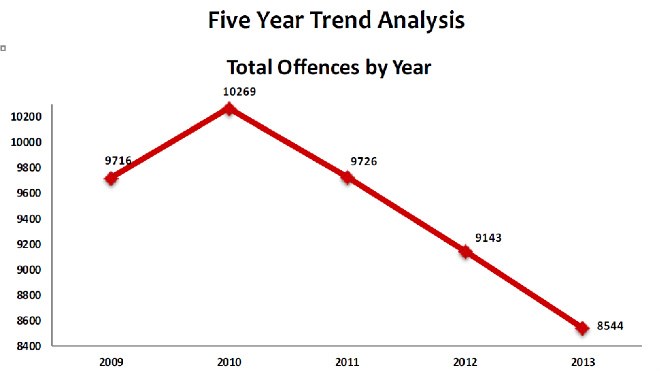But Paul Pedersen said this week that as policing models continue to evolve, adding more frontline officers isn't necessarily the answer to lowering crime rates further.
“Hiring more police officers will never be the sole solution to community safety,” he told reporters on Wednesday. “In many cases, a dollar spent on housing can fight crime better than a dollar spent on policing. So we have to have that conversation.
“(But) it's equally impractical to say that we can reduce numbers and maintain service levels.”
Pedersen spoke as Acting Police Chief Dan Markiewich was telling members of the police services board that crime rates again declined in Greater Sudbury last year, with the number of offences dropping in almost every major category.
With declining crime rates, and salaries now taking up 90 per cent of the $51 million police budget, pressure is increasing to get costs under control. After a reprieve for a few years, when a number of veteran officers retired and were replaced with constables lower on the salary grid, budget increases are being partially driven by mandated salary increases each year.
Greater Sudbury Mayor Marianne Matichuk said there's an opportunity to look for efficiencies, but it must be done carefully to ensure that crime statistics stay on the downward trajectory.
“We have to understand why (crime is going down) and whether there's an opportunity to do that,” Matichuk said. “Maybe you start looking at attrition, later on, so you can shrink your force, but still have the same good (crime) statistics that we saw.”
The way to do that, she said, is to consult with police and other staffers to see what could be done better, so the city can get the same amount of policing for lower cost. For example, the mental-health diversion program pioneered by the Greater Sudbury Police has freed up a significant amount of police time.
Under that program, rather than wait in hospital emergency departments for hours when dealing with people with mental health issues, police now bring them to a special clinic open for extended hours. Police are also no longer involved in city bylaw enforcement, Matichuk said.
“That's going to free up police time,” she said. “And that's a good thing, because we have to start looking for efficiencies – not just in police, but everywhere … Budgets keep getting cut, cut, cut. Look at the OPP – cut, cut, cut. Everybody's got to start looking at it.”
Matichuk said Pedersen is the type of modern police chief who can tackle these sorts of challenges.
“He's a very educated and forward-thinking individual (and) it's the reason why he rose to the top of our selection process,” she said. “He is someone who will look for efficiencies. He showed us quite a few models when we were interviewing him.
“He's someone who thinks outside the box, and I think there's going to be opportunities to look for efficiencies … You need to get more product out of the salary that you're spending, rather than adding another person.”
Just the facts:
Following national and provincial trends, the number of total offences dropped for the third straight year, to 8,544 in 2013. That compares to a high in 2010 of 10,269, with the number of offences dropping by about 500-600 a year in 2011 and 2012.
The number of violent offences dropped to 1,608 in 2013, compared to 1,682 in 2012 and the peak in 2010 of 1,845; the number of property offences dropped to 4,832, compared to 5,310 in 2012 and 6,319 in 2010.
Markiewich told the board that 85 per cent of calls to police are not related to offences. Of the 49,392 calls they received for service in 2013, only 8,544 were related to crimes. Over the last three years, the number of calls to police have dropped, as have the percentage of calls related to offences.
However, there was one crime category that saw an increase – sexual violations, which increased to 149, up by five in 2013 compared to 2012. The only other major crime category that saw an increase were charges related to drug offences and the Youth Criminal Justice Act, which rose to 592 in 2013, compared to 542 in 2012.
Join Sudbury.com+
- Messages
- Post a Listing
- Your Listings
- Your Profile
- Your Subscriptions
- Your Likes
- Your Business
- Support Local News
- Payment History
Sudbury.com+ members
Already a +member?
Not a +member?
Sign up for a Sudbury.com+ account for instant access to upcoming contests, local offers, auctions and so much more.
